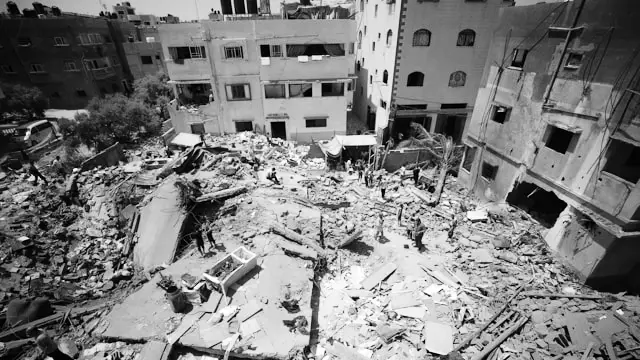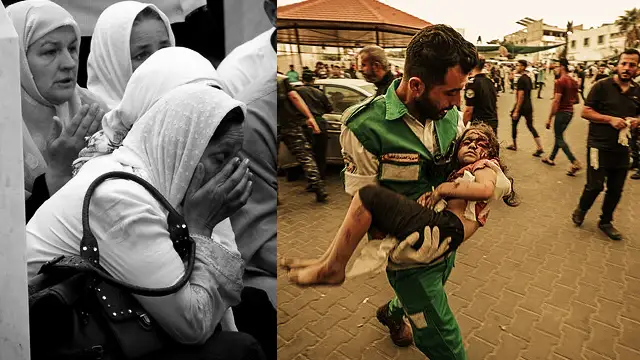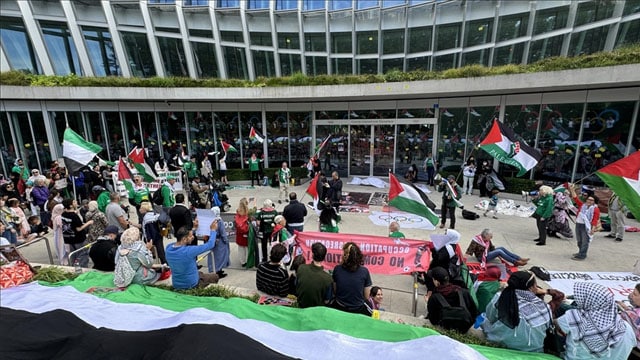The systematic destruction of Gaza has reached proportions that defy conventional metrics of warfare. Over 534 days, what officials from the Government Media Office in Gaza term a “genocide war” has transformed one of the world’s most densely populated territories—also called the world’s largest open-air prison—into a wasteland of rubble and despair. Gaza’s humanitarian catastrophe that has unfolded presents not merely a crisis of numbers but an existential threat to Palestinian society itself.
Gaza’s humanitarian catastrophe: Arithmetic of annihilation
Gaza’s humanitarian catastrophe has produced statistics that beggar belief: 61,221 killed and missing persons. Of these, 50,021 deaths have been documented by hospitals under Gaza’s Ministry of Health, while 11,200 individuals remain missing—buried under debris or simply unaccounted for in the chaos of unrelenting bombardment. These people, each with a story, won’t even make up to history’s footnote, critics say.
Children, who comprise approximately half of Gaza’s population, have borne a disproportionate burden of this humanitarian catastrophe. The data indicates 17,954 children being killed by Israeli forces, including 274 newborns who perished shortly after their birth and 876 infants under one year old. Women account for 12,365 of the documented fatalities.
Those tasked with preserving life and documenting truth have themselves become casualties: 1,394 medical personnel, 105 Civil Defence workers, 206 journalists, and 743 aid security forces. One wonders what Israel would call this pattern if not for the systematic elimination of those who heal, rescue, document and protect.
“Precision strikes,” Israeli officials insist. One must admire their precision—if the target is the very infrastructure of Palestinian society.
Families fractured
The scale of Gaza’s humanitarian catastrophe extends beyond individual losses to the very structure of Palestinian society. The data shows 12,000 distinct massacres, with 11,850 specifically targeting Palestinian families. The result: 2,165 families have been completely erased, accounting for 6,161 deaths.
Perhaps more harrowing still are the 5,064 families reduced to a single survivor—lone witnesses to the obliteration of 9,272 relatives. Gaza’s humanitarian catastrophe has orphaned 39,384 children and widowed 14,323 women.
Western observers might wonder how precisely Israeli forces distinguish between a “family home” and a “terrorist hideout.” The consistency of these numbers suggests a distinction without a difference.
Medical misery
For those who survived the initial blasts, Gaza’s humanitarian catastrophe continues in overwhelmed medical facilities. Hospitals have treated 113,274 wounded, including 17,000 requiring long-term rehabilitation. Among them are 4,700 amputees—nearly one in five being children.
The collapse of Gaza’s health system amid this humanitarian catastrophe means 22,000 patients require urgent treatment abroad, while 12,500 cancer patients lack adequate care. Approximately 60,000 pregnant women face heightened risks due to a scarcity of maternal services. Meanwhile, 350,000 chronic illness patients go without medications, and displacement has triggered over 2.1 million cases of infectious disease.
“Avoiding civilian casualties” takes on a certain ironic resonance when hospitals themselves become targets in this humanitarian catastrophe. Perhaps they contained too many civilians.
Displacement without destination
Gaza’s humanitarian catastrophe has displaced virtually the entire population of the enclave—approximately 2 million people—multiple times. The shelter situation remains catastrophic, with 110,000 tents described as “unsuitable for living,” while 280,000 families require new shelters.
Housing destruction in this humanitarian catastrophe has been comprehensive: 165,000 units completely destroyed, 115,000 severely damaged, and another 200,000 partially destroyed. In simpler terms: the majority of homes in Gaza no longer exist or are uninhabitable.
One might call it a curious form of “self-defence” that requires the destruction of nearly every dwelling in a territory. What precisely is being defended when nothing remains?
The vanished
Beyond the dead and wounded, Gaza’s humanitarian catastrophe has resulted in 6,628 Palestinian hostages taken to Israel, including 360 healthcare workers, 48 journalists, and 26 Civil Defence personnel. Reports indicate three doctors were executed in detention.
When Israel speaks of “intelligence gathering,” one might wonder what intelligence they hoped to gather from physicians whose crime was treating patients amid this humanitarian catastrophe.
Education eliminated
Long before the current crisis, education represented a cornerstone of Palestinian identity and resistance. Gaza’s humanitarian catastrophe has decimated this foundation: 139 schools and universities have been completely destroyed, 359 have been partially destroyed, and 785,000 students have been deprived of education.
What strategic threat could possibly be posed by textbooks and classrooms? Perhaps knowledge itself is deemed a threat to Israel’s colonial occupation amid this humanitarian catastrophe.
Cultural erasure
Gaza’s humanitarian catastrophe has not spared cultural and religious sites. Officials report 825 mosques have been completely destroyed and 161 severely damaged, along with three churches. Even the dead have not been left in peace, with 19 cemeteries damaged or destroyed and claims of 2,300 bodies stolen by Israel. What possible threat would a corpse pose to Israel?
A total of 206 historical and heritage sites have been destroyed—echoing concerns raised by UNESCO about cultural erasure in the region. This aspect of the humanitarian catastrophe represents not merely physical destruction but an assault on collective memory and identity.
The military necessity of targeting cemeteries remains elusive unless the goal of this humanitarian catastrophe extends beyond the living to erasing evidence that Palestinians ever existed at all.
Infrastructure obliterated
Gaza’s humanitarian catastrophe has systematically dismantled its infrastructure: 34 hospitals have been attacked or rendered non-functional; 162 healthcare facilities targeted with 80 completely shut down; 138 ambulances destroyed; and 42 sports facilities reduced to rubble.
Basic utilities have been methodically disabled in this humanitarian catastrophe: 719 water wells destroyed; 3,700km of electrical networks ruined; 2,105 electrical transformers broken; 330,000 metres of water networks demolished; 655,000 metres of sewage networks damaged; and 2,846,000 metres of roads rendered unusable.
One struggles to identify the military objective in depriving civilians of water, electricity, and sanitation—unless civilian suffering itself is the objective in this humanitarian catastrophe.
The balance sheet of destruction
In total, Palestinian officials estimate that over 88% of Gaza’s infrastructure has been destroyed in this humanitarian catastrophe, with initial direct losses exceeding $41bn. They claim that approximately 100,000 tons of explosives have been dropped on the territory—equivalent, they suggest, to seven atomic bombs.
The humanitarian catastrophe in Gaza presents a stark question: how does one reconstruct what has been so thoroughly unmade? More pointedly, what becomes of a society when nearly every institution that defines it—family, education, healthcare, cultural heritage—has been systematically targeted?
As Gaza’s humanitarian catastrophe continues to unfold, these statistics represent more than numbers. They are the actuarial tables of catastrophe—an attempt to document what may otherwise be forgotten as the world’s attention inevitably shifts elsewhere. In the absence of resolution, these numbers will only grow, adding new entries to what is already one of the most devastating humanitarian crises of the modern era.
The international community’s response to this humanitarian catastrophe has been characterised by expressions of “deep concern” coupled with continued arms shipments. One wonders what precisely would constitute a threshold for action, if not this.







